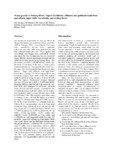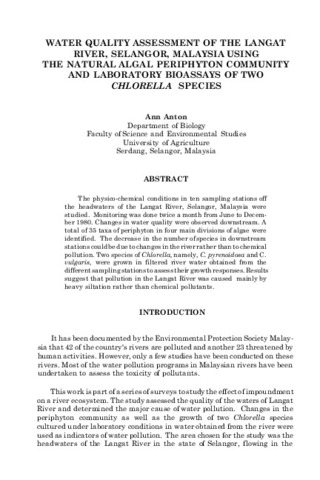Domestic effluents and pollution in Imbang River, Negros Occidental
| dc.contributor.author | Gonzales, Guadiosa A. | |
| dc.contributor.editor | Bagarinao, Teodora | |
| dc.date.accessioned | 2018-02-23T06:53:03Z | |
| dc.date.available | 2018-02-23T06:53:03Z | |
| dc.date.issued | 2007 | |
| dc.identifier.citation | Gonzales, G. A. (2008). Domestic effluents and pollution in Imbang River, Negros Occidental. In T. U. Bagarinao (Ed.), Research Output of the Fisheries Sector Program (Vol. 2. Reports on Fisheries and Aquaculture, pp. 77-82). Quezon City, Philippines: Bureau of Agricultural Research, Department of Agriculture. | en |
| dc.identifier.isbn | 9718511776 | |
| dc.identifier.uri | http://hdl.handle.net/10862/3267 | |
| dc.description.abstract | Domestic effluents, or waste waters from human settlements, were sampled from eight stations along Imbang River in Negros Occidental from July 1993 to February 1995. Three types of domestic waste waters were produced by communities along Imbang River. Waste waters from clothes washing, house cleaning, and bathing, including washings of domestic animals and holding pens and run-off from rains and storms were conveyed by open canals and ditches to the river. This type of domestic effluents were well aerated and had the least potential to degrade the rivers. Waste waters from kitchens and markets carried large volumes of food scraps and other solid wastes, were unsightly, and smelled bad from the decomposition of garbage. Overflows from septic tanks were the most objectionable domestic effluents with offensive visual and olfactory properties. Domestic effluents had pH 4–7.6, dissolved oxygen of 0.5–7.2 ppm, and biochemical oxygen demand ranging from 2 to 240 ppm. The overflows from septic tanks were of the worst quality, with BOD 20x greater than household washings, and 6x more than kitchen and market effluents. Fecal coliform bacteria made up 93% of the total coliforms in the septic tank overflows, 86% in kitchen and market waste waters, and 39% in household washings. The domestic effluents from the communities around Imbang River had higher than allowable levels of BOD and solids. The 11 barangays with 16,486 households and 85,535 people loaded about 3,4000 m3 of waste water into the river every day. Along with the waste water were 180 mt/yr of BOD, 590 mt/yr of total solids, plus large quantities of nutrients, surfactants, and fecal coliform bacteria. | en |
| dc.language.iso | en | en |
| dc.publisher | Bureau of Agricultural Research, Department of Agriculture | en |
| dc.subject | Philippines | en |
| dc.title | Domestic effluents and pollution in Imbang River, Negros Occidental | en |
| dc.type | Book chapter | en |
| dc.citation.spage | 77 | |
| dc.citation.epage | 82 | |
| dc.citation.bookTitle | Research Output of the Fisheries Sector Program | en |
| dc.subject.asfa | effluents | en |
| dc.subject.asfa | runoff | en |
| dc.subject.asfa | freshwater pollution | en |
| dc.subject.asfa | domestic wastes | en |
| dc.subject.asfa | waste disposal | en |
| dc.subject.asfa | faecal coliforms | en |
| dc.subject.asfa | pH | en |
| dc.subject.asfa | dissolved oxygen | en |
| dc.subject.asfa | biochemical oxygen demand | en |
| dc.subject.asfa | pollutants | en |
| dc.subject.asfa | rivers | en |
このアイテムのファイル
| ファイル | サイズ | フォーマット | 閲覧 |
|---|---|---|---|
|
このアイテムに関連するファイルは存在しません。 |
|||



